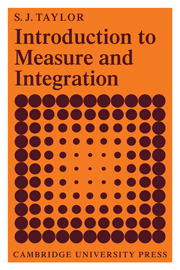Book contents
- Frontmatter
- Contents
- Preface
- 1 Theory of sets
- 2 Point set topology
- 3 Set functions
- 4 Construction and properties of measures
- 5 Definitions and properties of the integral
- 6 Related spaces and measures
- 7 The space of measurable functions
- 8 Linear functionals
- 9 Structure of measures in special spaces
- Index of notation
- General Index
- Frontmatter
- Contents
- Preface
- 1 Theory of sets
- 2 Point set topology
- 3 Set functions
- 4 Construction and properties of measures
- 5 Definitions and properties of the integral
- 6 Related spaces and measures
- 7 The space of measurable functions
- 8 Linear functionals
- 9 Structure of measures in special spaces
- Index of notation
- General Index
Summary
Metric space
In the first chapter we were concerned with abstract sets where no structure in the set was assumed or used. In practice, most useful spaces do have a structure which can be described in terms of a class of subsets called ‘open’. By far the most convenient method of obtaining this class of open sets is to quantify the notion of nearness for each pair of points in the space. A non-empty set X together with a ‘distance’ function ρ : X × X → R is said to form a metric space provided that
(i) ρ(y, x) = ρ(x, y) ≥ 0 for all x, y ∈ X;
(ii) ρ(x, y) = 0 if and only if x = y;
(iii) ρ(x, y) ≤ ρ(x, z) + ρ(y, z) for all x, y, z ∈ X.
The real number ρ(x, y) should be thought of as the distance from x to y. Note that it is possible to deduce conditions (i), (ii) and (iii) from a smaller set of axioms: this has little point as all the conditions agree with the intuitive notion of distance. Condition (iii) for ρ is often called the triangle inequality because it says that the lengths of two sides of a triangle sum to at least that of the third. Condition (ii) ensures that ρ distinguishes distinct points of X, and (i) says that the distance from y to x is the same as the distance from x to y. When we speak of a metric space X we mean the set X together with a particular ρ satisfying conditions (i), (ii) and (iii) above.
- Type
- Chapter
- Information
- Introduction to Measure and Integration , pp. 23 - 50Publisher: Cambridge University PressPrint publication year: 1973



